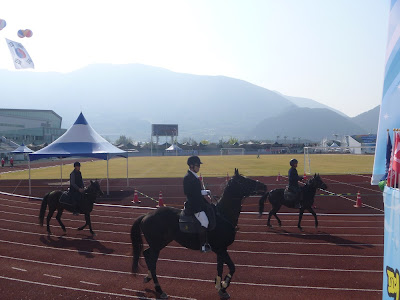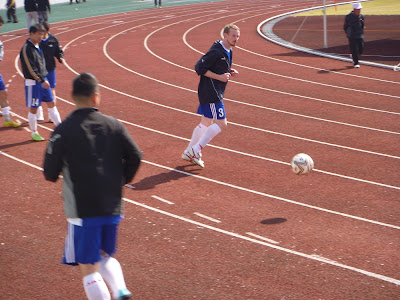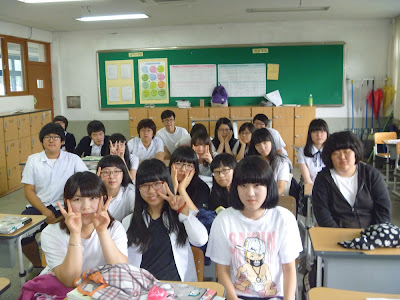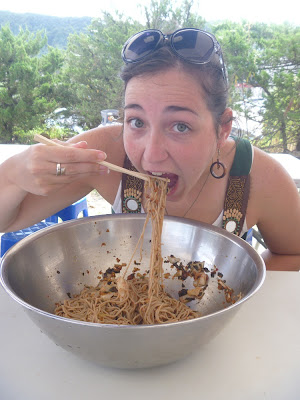This blog post is dedicated to one of my regular readers, who always emails so politely to enquire as to my health when I haven't written for a while. Apologies for the big gap between posts, a full explanation is below.
I'll start with the me update then, before I get on to the interesting anecdotes and pretty photos. I know I spend most of my time complaining about how busy I am in almost every blog post, but this time I really, really am. The first, and saddest, reason is that Linda has now gone back to the USA after her year in Korea. I'm not sure this is the appropriate place to say much about it, but what it did mean was that the weekends before she went were filled entirely with crossing things off the Korea bucket list. Again, more on that below.
Professionally things are getting more interesting right now. As well as teaching and studying (though I'm now a bit behind on my MA stuff) I'm also doing some extra work as a workshop presenter. Last weekend I gave a three hour workshop at a middle school in Gangneung on the application of technology for teaching writing, and in a couple of weekend's time I'm presenting at the Gangwon KOTESOL meeting on taking advantage of your student's expertise. The technology was great, and went really well, but required a couple of nights spent practising in front of the mirror, plus a while learning how to use and abuse Prezi to make a fancy presentation in keeping with the technological theme.
I can't remember, and can't be bothered to look, if I had made a decision on my future last time I wrote, but I have now finally decided to change jobs next year. As much as I love my little town, and my school, it's getting frustrating teaching students from whom perhaps two or three per year will go on to study English at university, despite it being one of the four core subjects in the curriculum. I feel I would be better served trying to help some students who actually want to speak English, rather than just pass their exams. Anyway, job hunting takes even more time, but I have a couple of interesting options for next year already, and hopefully a few more to come. I'm going to stay coy on those before they have actually happened, but I will be in Korea for sure next year.
I think that's most of the news about me for now. Oh, I will be back in England some time in the first couple of months of the year, but only for ten days at most. Once I have figured out when, I'll let you all know and see if we can figure out a time to have an ale or two.
The DMZ
One of the items on the above mentioned 'Korea bucket list' was to visit the DMZ, or demilitarized zone, a 4km wide area that runs the width of the peninsula and divides the two Koreas. A few weeks ago we booked ourselves on a tour, and on Saturday morning climbed on a bus and set off North Westwards from Seoul.
A brief history lesson then, to set you off. On 25th June, 1950 the Soviet supported Northern region of the Korean peninsula invaded the US and UN supported South. They made huge gains, driving the Southern forces several hundred km back almost to Busan on the south-east tip. Then MacArthur made a famous landing at Incheon, getting behind the North Korean troops and causing havoc. This meant that the UN forces drove the North back almost to the Chinese border, at which point the Chinese entered the war and pushed the UN forces back to more or less the 38th parallel, where everything had started. With something like 2 million casualties suffered by the two sides and the civilian population, a truce was called. Significantly though, this was not an armistice, and so technically the war continues to this day. Under the terms of the treaty, both sides pulled back their troops 2 km, a border was set up and thus the DMZ came into existence.
The first stop on the tour is the third infiltration tunnel. This was the scene of an attempted Northern incursion, which was promptly ended when an SK agent discovered the plot and grassed them up. Seemingly (and this is the impression I got, as I was chatting to someone during the talk) the North Koreans tried to claim it was a coalmine, to the point of covering it in coaldust. The South wasn't buying it though, and set up huge concrete barricades as well as flooding parts of the tunnel. Whatever, as an example of digging it's pretty impressive, being several hundred metres below ground and hewn through hard rock. Typically, with anything North Korean, it was also intended for people about 4 foot 6 high. I'm noticing a strong correlation between NK sightseeing and safety helmets. Due to it being a tunnel, and thus not particularly photogenic, you'll have to make do with this description.
Next stop was the observation platform. This gave us our first real glimpse of the DMZ, and it's only human settlements. Under the terms of the treaty two villages were allowed in the DMZ, one North and one South. There is also the Kaesong industrial region, where North and South Koreans work side by side, though they are not allowed to talk to each other. If you look at the photo below, you can see Kaesong to the left, The North Korean village in the centre, and the white flag on the far right is the South Korean village of Daeseong. This was the tallest flagpole in the world when the South donated it to the village, until of course the North built a bigger one. Life in the DMZ seems pretty sweet. You don't pay taxes and the government buys 100% of your rice crop. You also dodge the mandatory national service that the rest of the country has to do. The flipside is that you havea midnight curfew, and absolutely bugger all to do seemingly. Interestingly, if you meet a girl from Daeseong you're not allowed to marry her and move into the village to escape your military service.

The three settlements in the DMZ.

Yeah, I'm wearing a lumberjack shirt. Yes, I'm annoyed that it suits me.
After that we headed down to the last station in South Korea. Trains obviously don't run any further than this, but the tracks run on into the DMZ and allegedly link up with the trans-siberian railway above North Korea. Apparently this is a sentimental place for Koreans, which is odd as it's a large, clinical and deserted modern station.

If it wasn't for Kim Jong Il I could go home on the train!

"To Pyeongyang" is more in hope than timetabling.

The checkpoint that leads to the Kaesong industrial complex.
After a stop for lunch, we got to the highlight of the tour - a visit to Panmunjeom. This is the village that contains 'Conference Row', where negotiations between the two sides usually take place. We get an official American Military Police escort, the aptly and brilliantly monickered "Specialist Blood" (some wit on the bus asks him if it's his real name) and a briefing in which we are told that the North Koreans might come down to look at us, and on no account to communicate or make eye contact with them. After that it's off to the real thing. Panmunjeom is even more eeriely quiet than the rest of the DMZ. The sole signs of life are the three Korean MP's (there for our protection) who stand in Taekwondo poses staring blankly across the border to the NK side. The prospect of being investigated by the North Koreans doesn't really materialize, except for the lone soldier on the Northern side steps who picks up a pair of binoculars for a better look. I wonder what he makes of us photographing him. From what I read of life in the North, very very few people have cameras of any sort, let alone ones built in to phones like the one I'm wielding. Does he think we're just propaganda paraded by the Imperialist South? (Are we?)
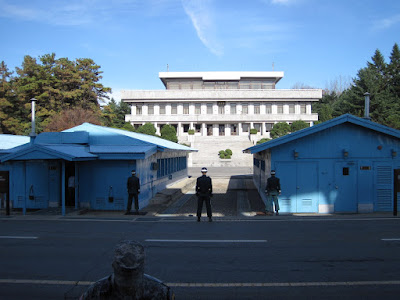
Conference Row and the NK building.

Specialist Blood.

I might be wondering if I'm about to get shot in this photo. More likely I'm just hating having my photo taken.

Being observed by the North. Look closely and you can see the guy with his binoculars.
Probably the most exciting part of the tour is going into the centre building of Conference Row. The building itself is pretty unexciting, just a blue hut with a large wooden table in the centre. We're asked to file around the table, and being near the front we find ourselves on the far side. It's at this point that Specialist Blood informs us that we just wandered into "Communist North Korea". It feels a bit odd to be honest, standing in the country that is always slightly overshadowing our lives here. We get told a couple of good stories, one about a South Korean guard who was left alone in the building and was dragged through to the Northern side, and another about a Northern soldier who got into the conference room, whose feet were so rank that whatever was on them ate the varnish on the table away. We pose for some photos with the guards, and then leave North Korea again.

On holiday in the North.

"I know what'll be really original. I'll copy this soldier's pose. No-one else will have though of that..."

Straddling the border.

The point of the soldier's pose, expression and glasses is to convey no emotion whatsoever towards the North. Has Linda grasped this fact? I'll let you decide.
The final part of the tour takes us out to Guardpost Three, and then the Bridge of No Return and the Axe Murder Incident Memorial. Guardpost Three is one of the furthest advanced points in the DMZ, surrounded on three sides by North Korean territory. From here you get an excellent view of the North Korean Propaganda Village, which is entirely unoccupied, except for the enormous flag fluttering above it. I say fluttering, it's probably more of a flap as the flag weighs enough that it takes 30 men to raise and lower it, which happens quite often as in strong winds it's heavy enough to tear itself to pieces. For any potential mercenaries out there, a 1m by 1m piece of the flag carries a significant bounty from Soldier of Fortune magazine.

The white posts there mark the border between North and South.
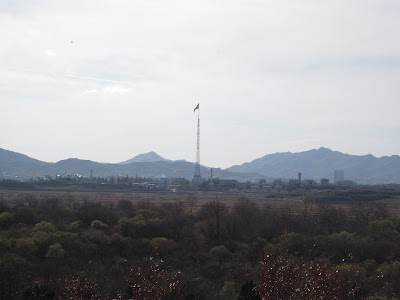
There's the flag, and your bounty. Don't be fooled by the pastoral appearance in front of it though. It's mostly a minefield.

Linda, backed by North Korea.

I rank North Korea among the prettiest of communist pariah states.
The last two sights on the tour are the site of the Axe Murder Incident and The Bridge of No Return. You can read the Wikipedia entry for the full story. I did think the soldier that told it to us told it with a little too much relish for one talking about the death of a fellow serviceman (think huge emphasis on "Bruuuuuuutal"). The Bridge of No Return was the site of prisoner exchanges once hostilities had ceased, and is no more accurately The Bridge of No Crossings At All, seeing as nobody has set foot on it since then.

The axe murder memorial.

The Bridge of No Return.
After those visits the tour finished with a trip to the gift shop, and then a bus ride back to Seoul past the Korean parliament building (below). If you happen to be in Korea, I can highly recommend this tour, but make sure that you do the USO one, as it's the only one that gets you into Panmunjeom, and hence allows you to bore your friends senseless with stories of the time you "went to North Korea". I'll be back soon, you lucky, lucky people.
Adios,
A



